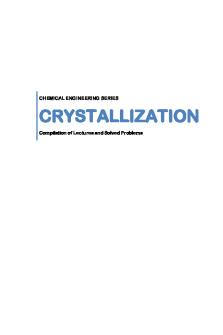Crystallization of copper(II) sulfate based minerals and MOF from solution: Chemical insights into the supramolecular interactions PDF20160505-7359-A4GU7J

| Title | Crystallization of copper(II) sulfate based minerals and MOF from solution: Chemical insights into the supramolecular interactions |
|---|---|
| Author | Dinesh Kumar |
| Pages | 13 |
| File Size | 855.5 KB |
| File Type | PDF20160505-7359-A4GU7J |
| Total Downloads | 443 |
| Total Views | 636 |
Summary
J. Chem. Sci., Vol. 122, No. 5, September 2010, pp. 757–769. © Indian Academy of Sciences. Crystallization of copper(II) sulfate based minerals and MOF from solution: Chemical insights into the supramolecular interactions M SINGH, D KUMAR, J THOMAS and A RAMANAN* Department of Chemistry, Indian Inst...
Description
J. Chem. Sci., Vol. 122, No. 5, September 2010, pp. 757–769. © Indian Academy of Sciences. 757 *For correspondence Crystallization of copper(II) sulfate based minerals and MOF from solution: Chemical insights into the supramolecular interactions M SINGH, D KUMAR, J THOMAS and A RAMANAN* Department of Chemistry, Indian Institute of Technology, New Delhi 110 016 e-mail: [email protected] Abstract. Crystallization of solids, molecular or non-molecular from solution is a supramolecular r tion. Nucleation of a lattice structure at supersaturation can be conceived to result from a critica a high energy intermediate (supramolecular transition state). Conceptualization of a struct critical nucleus in terms of aggregation of tectons through non-covalent interactions provides che insights into the architecture of a solid. The retrosynthetic analysis of copper-based minerals and als ofers an elegant description for the crystal packing. It addresses the infuence of the geomet tionality and reactivity of copper tecton(s) in directing a specifc supramolecular aggregat mechanistic approach provides guiding principles to chemists to account for the experimentally c lized solids and a platform to practice structure-synthesis correlation. Rationalization of the same sition with diferent atomic arrangements (polymorphs), compositional variation leading to pseudopolymorphs, degree of hydration (anhydrous to hydrated), water clusters, role of solvent, all be justifed on molecular basis. Also, the method gives predictive components including direct synthesize new solids. In a nutshell, the paper is an attempt to generalize the crystallization of in solids from solution by recognizing supramolecular interactions between metal tectons and gain for designing new MOF. Keywords. Crystallization; nucleation; supramolecular interaction; copper-based minerals; co tion polymer; MOF. 1. Introduction Materials research for the past few decades have been dominated by 3d transition metal based non- molecular oxides, halides, chalcogenides owing to their rich structural chemistry and a range of elec- tronic, magnetic, optical and catalytic properties. 1,2 Most of these materials are obtained through con- ventional solid state route wherein the reaction is essentially difusion-controlled leading to thermo- dynamically stable phases. However, in the recent past the focus has diverted towards another class of materials, organic inorganic hybrids 3 that include coordination polymers(CP) and metal organic frameworks (MOF) wherein the hard properties of inorganic ceramics and the fexibility of soft organic matrix are being integrated to obtain functional ma- terials. 4–6 Unlike molecular synthesis, preparation of solids relies heavily on exploratory methods, and it is well-recognized that the complexity of the possi- bilities often defes predictability. 7,8 In fgure 1 we highlight the three major activities of the chemistry of materials namely synthesis, structure and pro- perty at the corners of a triangle. Structure–property relationship is widely investigated for the past fe decades; Yaghi's reticular synthesis of MOF is a no- table example. 9,10 While structure–synthesis correla- tion is rarelyattempted due to lack of suitable mechanisms, designing or engineering a crystal t exhibit a particular set of properties for example porosity towards gas storage and separation still remains an elusive dream. Figure 1. Three major activities of the chemistry of materials....
Similar Free PDFs

2 Interactions - Notes from BDA
- 10 Pages

MOF Grupal - MOF TRABAJO GRUPLA
- 19 Pages

Properties of Common Minerals
- 1 Pages

ROCKS AND MINERALS
- 225 Pages

Vitamins and minerals
- 8 Pages

Vitamins and Minerals
- 7 Pages

Chemical Tutorial Solution P1
- 6 Pages

11.-MOF (Ayudante Perforista)of
- 2 Pages

Properties of Minerals
- 8 Pages
Popular Institutions
- Tinajero National High School - Annex
- Politeknik Caltex Riau
- Yokohama City University
- SGT University
- University of Al-Qadisiyah
- Divine Word College of Vigan
- Techniek College Rotterdam
- Universidade de Santiago
- Universiti Teknologi MARA Cawangan Johor Kampus Pasir Gudang
- Poltekkes Kemenkes Yogyakarta
- Baguio City National High School
- Colegio san marcos
- preparatoria uno
- Centro de Bachillerato Tecnológico Industrial y de Servicios No. 107
- Dalian Maritime University
- Quang Trung Secondary School
- Colegio Tecnológico en Informática
- Corporación Regional de Educación Superior
- Grupo CEDVA
- Dar Al Uloom University
- Centro de Estudios Preuniversitarios de la Universidad Nacional de Ingeniería
- 上智大学
- Aakash International School, Nuna Majara
- San Felipe Neri Catholic School
- Kang Chiao International School - New Taipei City
- Misamis Occidental National High School
- Institución Educativa Escuela Normal Juan Ladrilleros
- Kolehiyo ng Pantukan
- Batanes State College
- Instituto Continental
- Sekolah Menengah Kejuruan Kesehatan Kaltara (Tarakan)
- Colegio de La Inmaculada Concepcion - Cebu






